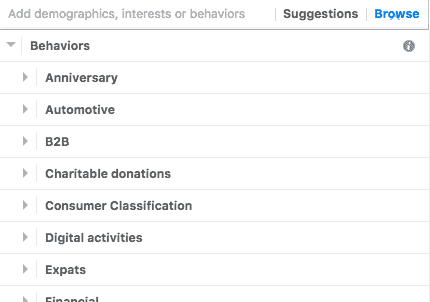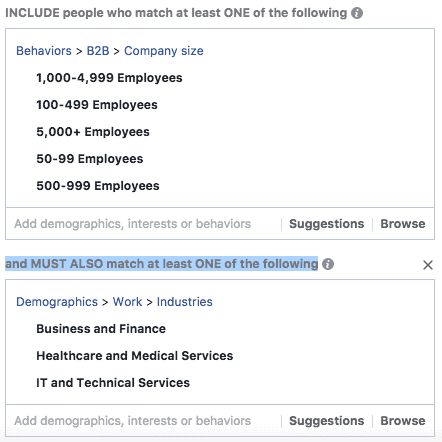Facebook Ad Targeting: Does size matter?

Knowing who your customers are is the first step in launching a successful Facebook Ads campaign. With more than 1.45 billion daily active Facebook users, it’s imperative that B2B companies target only those who are in their market segment. Otherwise, you’ll spend a lot of money advertising to a broad group of users. Thankfully, there is a wide range of Facebook ad targeting options that will help you!
Does Size Matter

One of the biggest questions in Facebook advertising is, “What’s the best audience size?” or, “What audience size should I target?” Now, a lot of “gurus” and money hungry “experts” will tell you that you need a targeting strategy that’s going to pull in between 500,000 – 1 million users. However, the most important part of your Facebook ad targeting isn’t the size, it’s the relevance of an audience to what you are offering. What you’re offering to an audience should be something that’s on their mind, or a problem they encounter daily. You should never pass on showing your ad to a hyper targeted audience because you think the audience size is too small.
If your goal is to target an audience of a specific size versus an audience with specific traits, you’re going to have an audience that likely won’t work for your business. This means you’re going to spend more money waiting for Facebook to find people interested in your ad than you would if your ads were hyper targeted.
How Do I Hyper Target?

It all starts with knowing your audience:
- What are their job titles?
- What’s their education level?
- Where do they live?
- What are their political views?
- What’s their age range?
- What’s their income?
These, and more, are all questions that need to be answered in order to complete buyer personas. This is not only important to Facebook, it should be a part of your marketing and sales strategy. If you don’t know who your audience is, where to find them, and how to speak to them, you’re not going to build a successful Facebook ad audience.
You can use combinations of data (such as behaviors, demographics, and geolocation) to match ad creative to a hyper targeted audience. The more relevant your offers are to the audience you’ve created, the higher your click-through rates and the lower your cost per click will be. There are several ways to narrow audiences, and there’s no reason to stick to just one or two filters.
Facebook Ad Targeting Strategies
Target Real Data
Facebook provides a large list of ad-targeting parameters that help marketers home in on just the right users. You can actually go so hyper targeted with Facebook Ad targeting that you can market to individuals. These parameters become more effective when you start layering one on top of another. Consider demographics— You may want to target people of a certain age, in a specific city. Define your audience further by also including a topic your target audience is interested in, such as big data. Now you’re not relying only on demographic data, but data that tells us these people will have a greater interest in your product.
Take your targeting a step further with behavioral targeting, like mobile device users, life events, or recent purchases. Say that you’re marketing an app that only works on the newest iPhone. You want to target people who have recently purchased an iPhone. Or, if you’re running a campaign that is partnered with a charity or non-profit, you might target people who have made charitable donations on Facebook.
This data tells you more about the people you’re reaching out to, allowing you to serve them tailored offers they’re more likely to respond to.

AND/OR
When creating audiences, you have the ability to narrow with the AND/OR targeting options. Use the OR targeting to grow your audience. When you add a targeting option under the same category of targeting, your audience will grow larger—your ad will be served to people who match at least one of the targeting options you select.
Use the AND targeting to decrease your audience size and create niche audiences. You can choose to include people who match more than one interest, demographic, or behavior at a particular time. This targeting option means that a person who’s in your target audience must fall into multiple categories.

Exclude Data That Doesn’t Matter
If you don’t want to serve your ads to people who work for companies with fewer than 10 employees, exclude them. You can minimize the possibility of attracting users that don’t match your target audience by excluding people who match specific interests or demographics. Say your target is companies of 50+ employees, so exclude anyone who does not fit that criteria. You might also want to exclude government employees, retail employees, etc. All of these targeting options assist in narrowing your audience so you minimize the chance of attracting interest from people who will never convert to customers.

You can also exclude custom audiences from your campaigns. For example, you could exclude past converted users from your audience. This helps to avoid your ads reaching people who are already customers.
Facebook Audience Options
There are three options for choosing and building your audience on Facebook.
Custom Audience
One of the most basic and effective strategies, in terms of raw ad-targeting power, is custom audiences. By targeting people on Facebook who you’re already connected to, either on the Facebook platform or website visitors via Facebook pixel, you can grow relationships and drive sales. You can build a custom audience by creating a lists. Provide email addresses or phone numbers using your customer data. Upload your CSV or TXT file and voila!
Saved Audience
All companies, from new software start-ups to established enterprises with large clients, find value in Facebook’s “saved audience” option. Target users by leveraging the data Facebook has on all its users. These are things like demographics, interests, location, and company size to deliver meaningful ads.
Lookalike Audience
Lookalike audiences help you find people on Facebook who are similar to your customers, contacts, or Facebook page followers. It’s a powerful tool that uses examples of your real audience to increase the likelihood of reaching people who might be interested in your business. There are a few ways you can build lookalike audiences:
- Create a Video Lookalike Audience
- Set Up Email List Lookalike Audiences
- Create Conversion Lookalike Audiences
- Construct Page Likes Lookalike Audiences
Facebook packs a ton of value! If you’ve experimented with Facebook ads and didn’t get the results you wanted, keep trying. A lot of problems stem from targeting the wrong audience on the first go-around. There are a number of ways to target ads and build campaigns with different audiences and media. Try to remember that it’s okay to go through some trial and error to figure out the perfect mix that works for your business. Contact DemandZEN to get more information on how you can grow your business with Facebook ads!
You Might Also Enjoy These Posts
Demand Generation vs Lead Generation
Gamification Strategies: Badges in B2B Marketing
Welcome To DemandZEN
DemandZEN specializes in Account-Based Demand Generation and solving the challenges around finding, engaging and converting target accounts into real opportunities for B2B Technology and Services companies.


